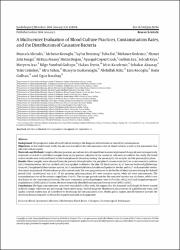A multicenter evaluation of blood culture practices, contamination rates, and the distribution of causative bacteria

Göster/
Erişim
info:eu-repo/semantics/openAccessTarih
2016Yazar
Altındiş, MustafaKoroğlu, Mehmet
Demiray, Tayfur
Dal, Tuba
Özdemir, Mehmet
Şengil, Ahmet Zeki
Atasoy, Ali Rıza
Doğan, Metin
Çiçek, Ayşegül Çopur
Ece, Gülfem
Kaya, Selçuk
Iraz, Meryem
Gültepe, Bilge Sümbül
Temiz, Hakan
Demirkan, İdris
Aksaray, Sebahat
Çetinkol, Yeliz
Şahin, İdris
Güdücüoğlu, Hüseyin
Kılıç, Abdullah
Koçoğlu, Esra
Gülhan, Barış
Karabay, Oğuz
Üst veri
Tüm öğe kaydını gösterKünye
Altindis, M., Koroglu, M., Demiray, T., Dal, T., Ozdemir, M., Sengil, A. Z., Atasoy, A. R., Doğan, M., Cicek, A. C., Ece, G., Kaya, S., Iraz, M., Gultepe, B. S., Temiz, H., Kandemir, I., Aksaray, S., Cetinkol, Y., Sahin, I., Guducuoglu, H., Kilic, A., … Karabay, O. (2016). A Multicenter Evaluation of Blood Culture Practices, Contamination Rates, and the Distribution of Causative Bacteria. Jundishapur journal of microbiology, 9(1), e29766. https://doi.org/10.5812/jjm.29766Özet
Background: the prognostic value of blood culture testing in the diagnosis of bacteremia is limited by contamination. Objectives: in this multicenter study, the aim was to evaluate the contamination rates of blood cultures as well as the parameters that affect the culture results. Materials and Methods: Sample collection practices and culture data obtained from 16 university/research hospitals were retrospectively evaluated. A total of 214,340 blood samples from 43,254 patients admitted to the centers in 2013 were included in this study. the blood culture results were evaluated based on the three phases of laboratory testing: the pre-analytic, the analytic, and the post-analytic phase. Results: Blood samples were obtained from the patients through either the peripheral venous route (64%) or an intravascular catheter (36%). Povidone-iodine (60%) or alcohol (40%) was applied to disinfect the skin. of the 16 centers, 62.5% have no dedicated phlebotomy team, 68.7% employed a blood culture system, 86.7% conducted additional studies with pediatric bottles, and 43.7% with anaerobic bottles. One center maintained a blood culture quality control study. the average growth rate in the bottles of blood cultures during the defined period (1259 -26,400/year) was 32.3%. of the growing microorganisms, 67% were causative agents, while 33% were contaminants. the contamination rates of the centers ranged from 1% to 17%. the average growth time for the causative bacteria was 21.4 hours, while it was 36.3 hours for the contaminant bacteria. the most commonly isolated pathogens were Escherichia coli (22.45%) and coagulase-negative staphylococci (CoNS) (20.11%). Further, the most frequently identified contaminant bacteria were CoNS (44.04%). Conclusions: the high contamination rates were remarkable in this study. We suggest that the hospitals' staff should be better trained in blood sample collection and processing. Sterile glove usage, alcohol usage for disinfection, the presence of a phlebotomy team, and quality control studies may all contribute to decreasing the contamination rates. Health policy makers should therefore provide the necessary financial support to obtain the required materials and equipment.

















